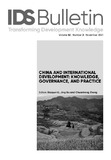Triangular Cooperation: Different Approaches, Same Modality
| dc.contributor.author | Prantz, Sebastian | |
| dc.contributor.author | Zhang, Xiaomin | |
| dc.coverage.spatial | China | en |
| dc.coverage.spatial | Germany | en |
| dc.coverage.spatial | Ethiopia | en |
| dc.date.accessioned | 2021-11-25T11:45:50Z | |
| dc.date.available | 2021-11-25T11:45:50Z | |
| dc.date.issued | 2021-11-29 | |
| dc.identifier.citation | Prantz, S. and Zhang, X. (2021) 'Triangular Cooperation: Different Approaches, Same Modality', IDS Bulletin 52.2: 139–56 | en |
| dc.identifier.issn | 1759-5436 | |
| dc.identifier.uri | https://opendocs.ids.ac.uk/opendocs/handle/20.500.12413/16957 | |
| dc.description.abstract | Triangular cooperation aims to utilise the comparative advantages of a pivotal partner (usually an emerging country) and a facilitating partner (usually a traditional donor) to generate development impacts with and for the benefit of a beneficiary, through simultaneously strengthening their partnership and providing opportunities for mutual learning. Utilising the triangular cooperation modality, China has acted primarily as a pivotal partner, implementing projects with facilitating partners and beneficiaries. Roles and responsibilities between China and facilitating partners differ greatly. Three approaches can be distinguished: (a) facilitating partner provides financial resources and China provides expertise; (b) China provides financial resources and facilitating partner implements; (c) China and facilitating partner provide financial resources and jointly plan and implement together with the beneficiary. This article argues that approach (c), currently practised in triangular cooperation projects between China, Germany, and beneficiary countries, provides the partners with the most potential for effectively generating developmental impacts and partnership effects. | en |
| dc.description.sponsorship | Foreign, Commonwealth & Development Office | en |
| dc.language.iso | en | en |
| dc.publisher | Institute of Development Studies | en |
| dc.relation.ispartofseries | IDS Bulletin;52.2 | |
| dc.rights | This is an Open Access article distributed under the terms of the Creative Commons Attribution 4.0 International licence (CC BY), which permits unrestricted use, distribution, and reproduction in any medium, provided the original authors and source are credited and any modifications or adaptations are indicated. http://creativecommons.org/licenses/by/4.0/legalcode | en |
| dc.rights.uri | http://creativecommons.org/licenses/by/4.0/ | en |
| dc.subject | Aid | en |
| dc.subject | Development Policy | en |
| dc.subject | Politics and Power | en |
| dc.title | Triangular Cooperation: Different Approaches, Same Modality | en |
| dc.type | Article | en |
| dc.rights.holder | © Authors © Institute of Development Studies 2021 | en |
| dc.identifier.team | Business, Markets and the State | en |
| dc.identifier.doi | 10.19088/1968-2021.125 | |
| rioxxterms.funder | Default funder | en |
| rioxxterms.identifier.project | Default project | en |
| rioxxterms.version | VoR | en |
| rioxxterms.versionofrecord | 10.19088/1968-2021.125 | en |
| rioxxterms.funder.project | 9ce4e4dc-26e9-4d78-96e9-15e4dcac0642 | en |
Files in this item
This item appears in the following Collection(s)
Except where otherwise noted, this item's license is described as This is an Open Access article distributed under the terms of the Creative Commons Attribution 4.0 International licence (CC BY), which permits unrestricted use, distribution, and reproduction in any medium, provided the original authors and source are credited and any modifications or adaptations are indicated. http://creativecommons.org/licenses/by/4.0/legalcode


